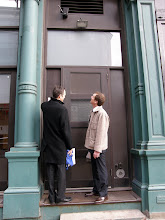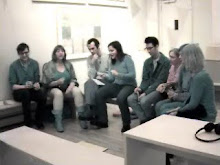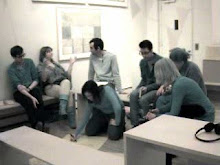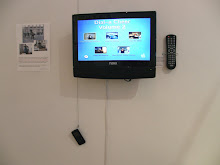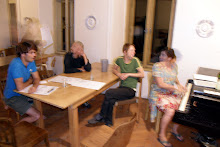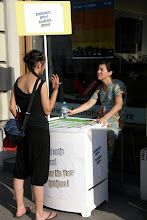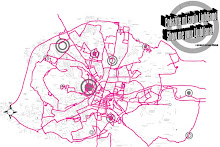How’d You Get that Awesome Residency? A resource-sharing workshop
Why do you want to do a residency?
Travel
Make uninterrupted work
Make site-specific work
Network
Get laid
Explore the unknown
Free/cheap studio space
.....
Where do you want to go?
local? national? international?
RESEARCH- your best friend
1. Transartists.nl - international residencies, festivals, etc
2. NYFA.org – grants and residencies, many NY & US based
3. Artservis – Slovenian, & good for Balkan opps
4. Resartis – international residencies with member orgs
5. Rhizome- opps of all kinds
6. Instant Coffee – Canada & international
7. Unesco Ascheburg- April DLl, developing countries/under 35 mostly
8. Eflux - opps/artist info
and more...
Once you find a place of interest, GO TO THEIR WEBSITE! I can’t stress this enough- that’s where you find out what’s really going on, maybe.. Sometimes the research sites have outdated info.
Who are the other artists who have been there? Are they all, say, Belgian, even though it claims to be an international organization? What career stages are they compared to you? Go to the artists’ websites! Do they accept mostly social practice based artists or painters or sound artists or all? You will be at a disadvantage because you are American.
Do they have a rotating curatorial staff? Do you want to make an impression on a particular curator?
The nicer the weather/more beautiful the location, the more the residency will cost, usually…
Do they want you to interact with the public? Are you willing?
Will you get to network with the local Art Scene?
Are you the only artist living in a remote farmhouse in Finland in the winter? Is that ok?
Are you in a shared housing situation? Is that ok?
How does eating/food purchasing/cooking work? Are you required to be communal?
Do you have to leave a piece of art? Is that ok?
Can you do your project in the allotted time? Are you willing to be away from your family & friends for 6 months?
Can you bring your parter/children/pet?
Some types of residencies
Art vacations
Cultural explorations
Deep work/research/alone time
Social networking
DIY (often great staff, no money)
Institutional (often too-busy staff)
Government
Paid/unpaid
This is one of the few cases where ‘paying to play’ is acceptable. Some of these places give you amazing admin support, or a nice AC apartment, or.. Check the economic status of the country and see how the cost fits in. I did a $400 Taipei residency and I bet it even covered my AC bill, whereas I got all the administrative support I could want. It was so cheap to be there it was totally worth it.
Others are straight up rip offs- look into it.
Make personal contact: introduce yourself and ask a question that can’t be answered on their site, but not ‘will you preview my work?’. Personal contact can make you memorable, and you can ask some of those questions above. Don't sound too needy, as the administrators may not want to work with you...
Follow directions!
Do multiple applications at once, because you will fail- get over it and try again. On average, I’d say, as emerging artists we get one in ten.
Get your package together, so you can have it ready to send in 30 minutes (so you can apply to 5 at a time, because you will be rejected.. but fear not! You will get some!)
1.Portfolio – a concise body of work – have around 20 available images
Image list, organized with titles, dates, media, information – last 2-3 years at most
Photograph/Photoshop/size/
Most places want digital files but some in Europe still go for the ‘book’, with photos, sketches, resource images, etc.- you can be really creative with those.
Video- is it Mac/PC compatible? NTSC or PAL? You should be prepared for both.
Music/writing/video samples- usually you are asked for 3-5
Each institution will want something different, so have the images ready to cut down to 10, or to email, etc.
2. C.V
List of exhibitions, projects, reviews, education, lectures, etc.
Be creative yet informative
3. Statement
Remember you may be dealing with foreign ESL folk- do not get too heady with your explanations. Be concise, clear, and creative. The Germans may respond to mentioning a German philosopher while the Taiwanese may relate more to quoting Confucius. Also, the curators/jury have to read a lot of these...
4. Project Outline- this will change package to package, but again, be clear
What are your goals (make 10 paintings, research igloo construction, write an opera, etc..)
How do they relate to the organization’s philosophy or the theme of the residency?
What is you work plan (week one.. week two…)
Good to mention cross cultural understanding/ambassadorsh
Again, potential foreign ESL curators- be clear & use simple language
Some places don’t care
Paying for your residency: It might be worth it
Grants
Sublet your place
Savings
Have a garage/studio sale
Get a cc with miles
What, if anything is the institution willing to pay for? Maybe their funding covers only travel, or only materials with receipts,..
Budgets: basically, identify expenses, itemize, and have your total equal what you're asking for. Usually you don't need a budget for a residency but sometimes you might.
Please feel free to add your own experience/expertise!



